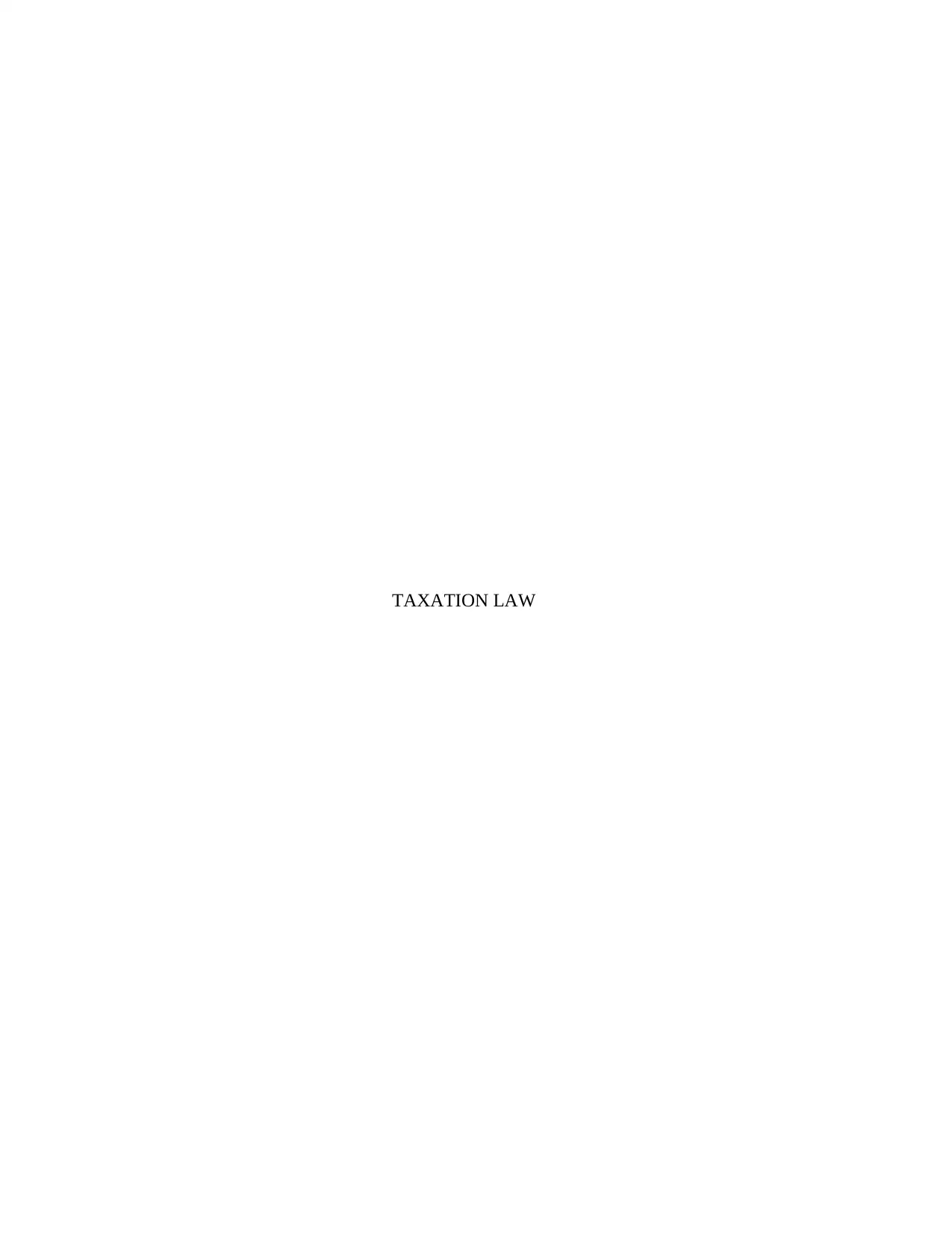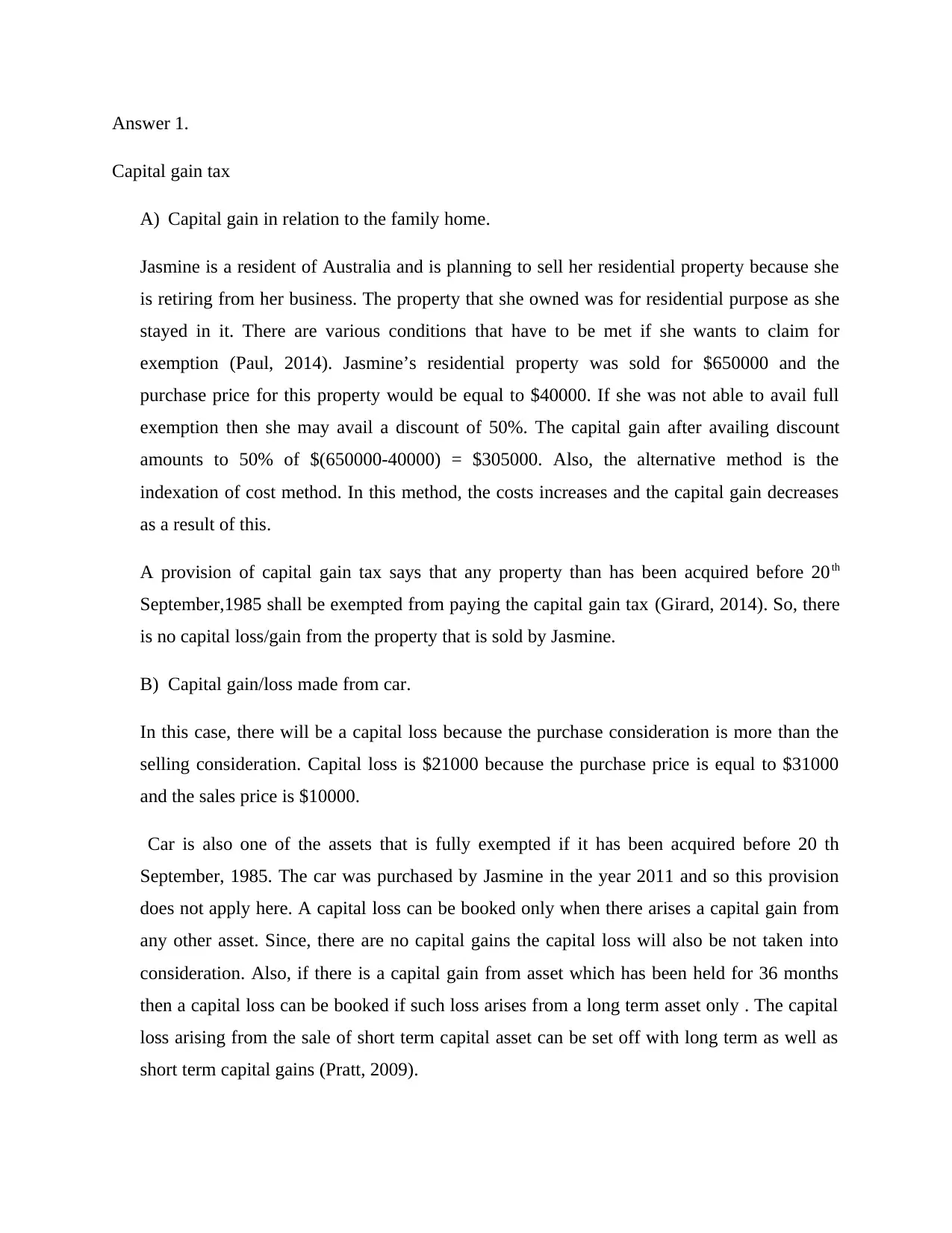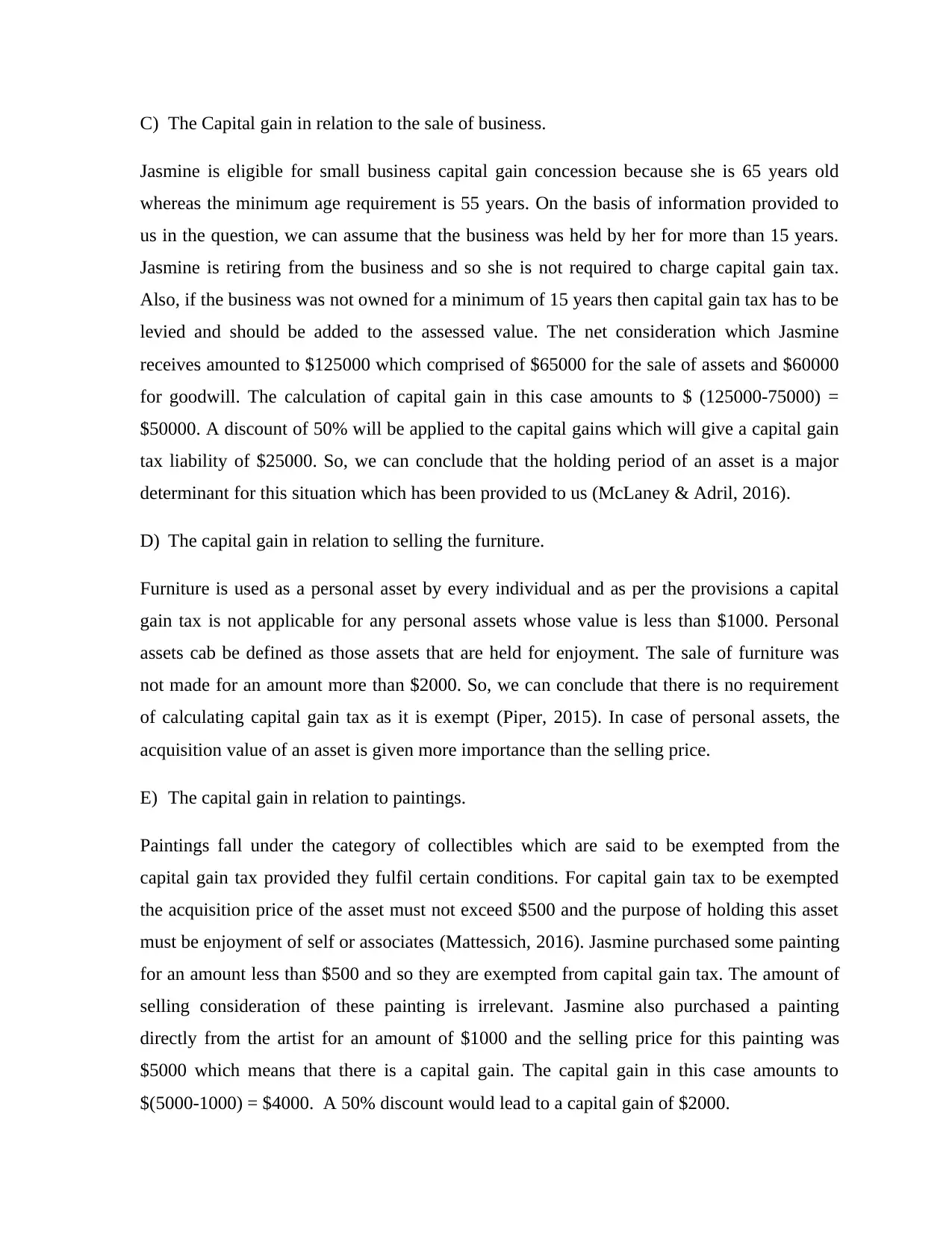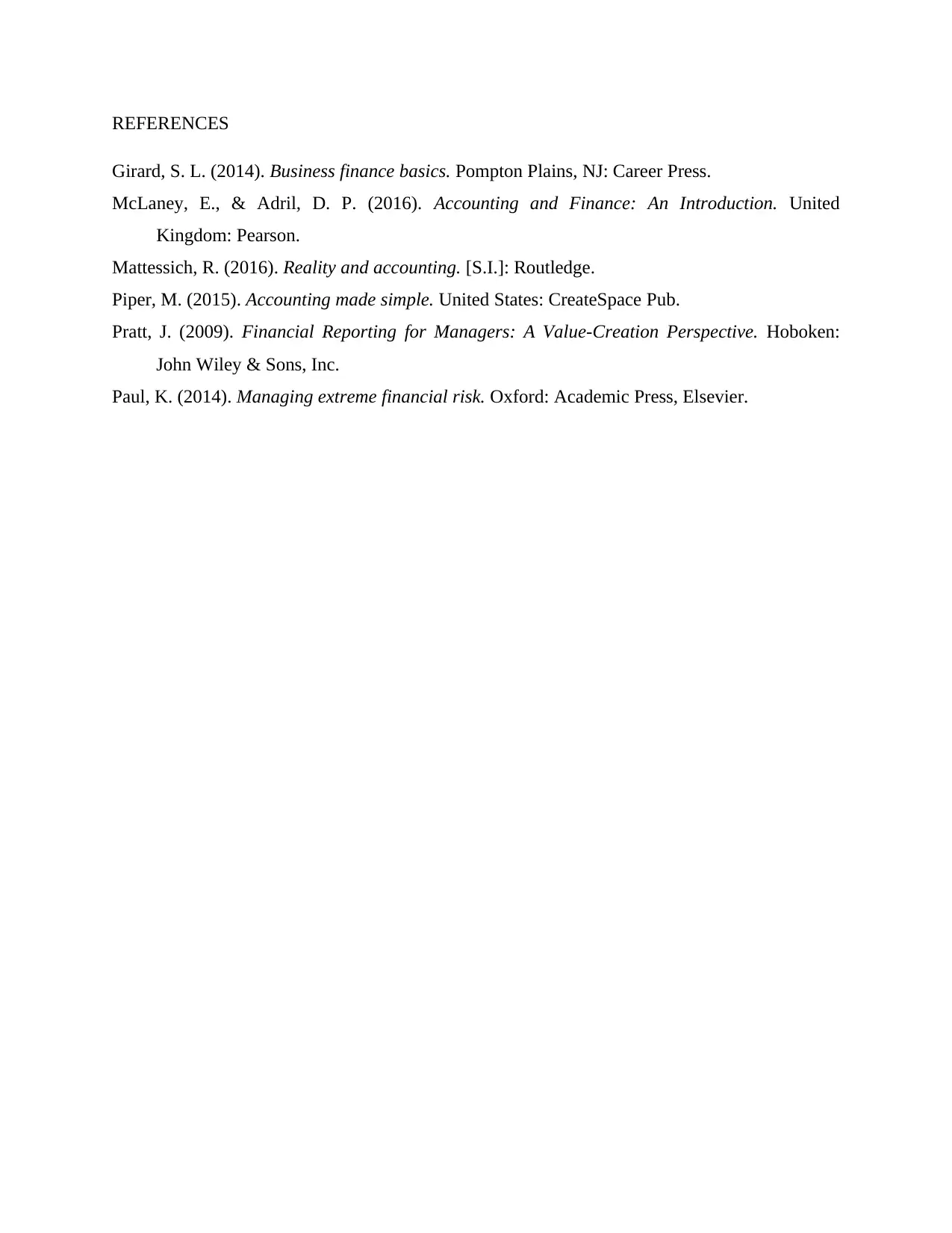Taxation Law: Capital Gains Tax Analysis of Residential Property
VerifiedAdded on 2022/10/07
|4
|1033
|22
Homework Assignment
AI Summary
This assignment analyzes Jasmine's capital gains tax liabilities arising from the sale of her residential property, car, business, furniture, and paintings. The analysis covers various aspects of capital gains tax, including exemptions for the family home, small business concessions, and the treatment of personal assets and collectibles. The solution determines the capital gain or loss for each asset, considering factors such as the purchase price, selling price, holding period, and relevant tax provisions. The assignment also addresses the application of the 50% discount for capital gains and the impact of capital losses. The analysis concludes with a summary of Jasmine's overall tax liability based on the provided information and relevant Australian tax law.

TAXATION LAW
Paraphrase This Document
Need a fresh take? Get an instant paraphrase of this document with our AI Paraphraser

Answer 1.
Capital gain tax
A) Capital gain in relation to the family home.
Jasmine is a resident of Australia and is planning to sell her residential property because she
is retiring from her business. The property that she owned was for residential purpose as she
stayed in it. There are various conditions that have to be met if she wants to claim for
exemption (Paul, 2014). Jasmine’s residential property was sold for $650000 and the
purchase price for this property would be equal to $40000. If she was not able to avail full
exemption then she may avail a discount of 50%. The capital gain after availing discount
amounts to 50% of $(650000-40000) = $305000. Also, the alternative method is the
indexation of cost method. In this method, the costs increases and the capital gain decreases
as a result of this.
A provision of capital gain tax says that any property than has been acquired before 20th
September,1985 shall be exempted from paying the capital gain tax (Girard, 2014). So, there
is no capital loss/gain from the property that is sold by Jasmine.
B) Capital gain/loss made from car.
In this case, there will be a capital loss because the purchase consideration is more than the
selling consideration. Capital loss is $21000 because the purchase price is equal to $31000
and the sales price is $10000.
Car is also one of the assets that is fully exempted if it has been acquired before 20 th
September, 1985. The car was purchased by Jasmine in the year 2011 and so this provision
does not apply here. A capital loss can be booked only when there arises a capital gain from
any other asset. Since, there are no capital gains the capital loss will also be not taken into
consideration. Also, if there is a capital gain from asset which has been held for 36 months
then a capital loss can be booked if such loss arises from a long term asset only . The capital
loss arising from the sale of short term capital asset can be set off with long term as well as
short term capital gains (Pratt, 2009).
Capital gain tax
A) Capital gain in relation to the family home.
Jasmine is a resident of Australia and is planning to sell her residential property because she
is retiring from her business. The property that she owned was for residential purpose as she
stayed in it. There are various conditions that have to be met if she wants to claim for
exemption (Paul, 2014). Jasmine’s residential property was sold for $650000 and the
purchase price for this property would be equal to $40000. If she was not able to avail full
exemption then she may avail a discount of 50%. The capital gain after availing discount
amounts to 50% of $(650000-40000) = $305000. Also, the alternative method is the
indexation of cost method. In this method, the costs increases and the capital gain decreases
as a result of this.
A provision of capital gain tax says that any property than has been acquired before 20th
September,1985 shall be exempted from paying the capital gain tax (Girard, 2014). So, there
is no capital loss/gain from the property that is sold by Jasmine.
B) Capital gain/loss made from car.
In this case, there will be a capital loss because the purchase consideration is more than the
selling consideration. Capital loss is $21000 because the purchase price is equal to $31000
and the sales price is $10000.
Car is also one of the assets that is fully exempted if it has been acquired before 20 th
September, 1985. The car was purchased by Jasmine in the year 2011 and so this provision
does not apply here. A capital loss can be booked only when there arises a capital gain from
any other asset. Since, there are no capital gains the capital loss will also be not taken into
consideration. Also, if there is a capital gain from asset which has been held for 36 months
then a capital loss can be booked if such loss arises from a long term asset only . The capital
loss arising from the sale of short term capital asset can be set off with long term as well as
short term capital gains (Pratt, 2009).

C) The Capital gain in relation to the sale of business.
Jasmine is eligible for small business capital gain concession because she is 65 years old
whereas the minimum age requirement is 55 years. On the basis of information provided to
us in the question, we can assume that the business was held by her for more than 15 years.
Jasmine is retiring from the business and so she is not required to charge capital gain tax.
Also, if the business was not owned for a minimum of 15 years then capital gain tax has to be
levied and should be added to the assessed value. The net consideration which Jasmine
receives amounted to $125000 which comprised of $65000 for the sale of assets and $60000
for goodwill. The calculation of capital gain in this case amounts to $ (125000-75000) =
$50000. A discount of 50% will be applied to the capital gains which will give a capital gain
tax liability of $25000. So, we can conclude that the holding period of an asset is a major
determinant for this situation which has been provided to us (McLaney & Adril, 2016).
D) The capital gain in relation to selling the furniture.
Furniture is used as a personal asset by every individual and as per the provisions a capital
gain tax is not applicable for any personal assets whose value is less than $1000. Personal
assets cab be defined as those assets that are held for enjoyment. The sale of furniture was
not made for an amount more than $2000. So, we can conclude that there is no requirement
of calculating capital gain tax as it is exempt (Piper, 2015). In case of personal assets, the
acquisition value of an asset is given more importance than the selling price.
E) The capital gain in relation to paintings.
Paintings fall under the category of collectibles which are said to be exempted from the
capital gain tax provided they fulfil certain conditions. For capital gain tax to be exempted
the acquisition price of the asset must not exceed $500 and the purpose of holding this asset
must be enjoyment of self or associates (Mattessich, 2016). Jasmine purchased some painting
for an amount less than $500 and so they are exempted from capital gain tax. The amount of
selling consideration of these painting is irrelevant. Jasmine also purchased a painting
directly from the artist for an amount of $1000 and the selling price for this painting was
$5000 which means that there is a capital gain. The capital gain in this case amounts to
$(5000-1000) = $4000. A 50% discount would lead to a capital gain of $2000.
Jasmine is eligible for small business capital gain concession because she is 65 years old
whereas the minimum age requirement is 55 years. On the basis of information provided to
us in the question, we can assume that the business was held by her for more than 15 years.
Jasmine is retiring from the business and so she is not required to charge capital gain tax.
Also, if the business was not owned for a minimum of 15 years then capital gain tax has to be
levied and should be added to the assessed value. The net consideration which Jasmine
receives amounted to $125000 which comprised of $65000 for the sale of assets and $60000
for goodwill. The calculation of capital gain in this case amounts to $ (125000-75000) =
$50000. A discount of 50% will be applied to the capital gains which will give a capital gain
tax liability of $25000. So, we can conclude that the holding period of an asset is a major
determinant for this situation which has been provided to us (McLaney & Adril, 2016).
D) The capital gain in relation to selling the furniture.
Furniture is used as a personal asset by every individual and as per the provisions a capital
gain tax is not applicable for any personal assets whose value is less than $1000. Personal
assets cab be defined as those assets that are held for enjoyment. The sale of furniture was
not made for an amount more than $2000. So, we can conclude that there is no requirement
of calculating capital gain tax as it is exempt (Piper, 2015). In case of personal assets, the
acquisition value of an asset is given more importance than the selling price.
E) The capital gain in relation to paintings.
Paintings fall under the category of collectibles which are said to be exempted from the
capital gain tax provided they fulfil certain conditions. For capital gain tax to be exempted
the acquisition price of the asset must not exceed $500 and the purpose of holding this asset
must be enjoyment of self or associates (Mattessich, 2016). Jasmine purchased some painting
for an amount less than $500 and so they are exempted from capital gain tax. The amount of
selling consideration of these painting is irrelevant. Jasmine also purchased a painting
directly from the artist for an amount of $1000 and the selling price for this painting was
$5000 which means that there is a capital gain. The capital gain in this case amounts to
$(5000-1000) = $4000. A 50% discount would lead to a capital gain of $2000.
⊘ This is a preview!⊘
Do you want full access?
Subscribe today to unlock all pages.

Trusted by 1+ million students worldwide

REFERENCES
Girard, S. L. (2014). Business finance basics. Pompton Plains, NJ: Career Press.
McLaney, E., & Adril, D. P. (2016). Accounting and Finance: An Introduction. United
Kingdom: Pearson.
Mattessich, R. (2016). Reality and accounting. [S.I.]: Routledge.
Piper, M. (2015). Accounting made simple. United States: CreateSpace Pub.
Pratt, J. (2009). Financial Reporting for Managers: A Value-Creation Perspective. Hoboken:
John Wiley & Sons, Inc.
Paul, K. (2014). Managing extreme financial risk. Oxford: Academic Press, Elsevier.
Girard, S. L. (2014). Business finance basics. Pompton Plains, NJ: Career Press.
McLaney, E., & Adril, D. P. (2016). Accounting and Finance: An Introduction. United
Kingdom: Pearson.
Mattessich, R. (2016). Reality and accounting. [S.I.]: Routledge.
Piper, M. (2015). Accounting made simple. United States: CreateSpace Pub.
Pratt, J. (2009). Financial Reporting for Managers: A Value-Creation Perspective. Hoboken:
John Wiley & Sons, Inc.
Paul, K. (2014). Managing extreme financial risk. Oxford: Academic Press, Elsevier.
1 out of 4
Related Documents
Your All-in-One AI-Powered Toolkit for Academic Success.
+13062052269
info@desklib.com
Available 24*7 on WhatsApp / Email
![[object Object]](/_next/static/media/star-bottom.7253800d.svg)
Unlock your academic potential
Copyright © 2020–2025 A2Z Services. All Rights Reserved. Developed and managed by ZUCOL.




